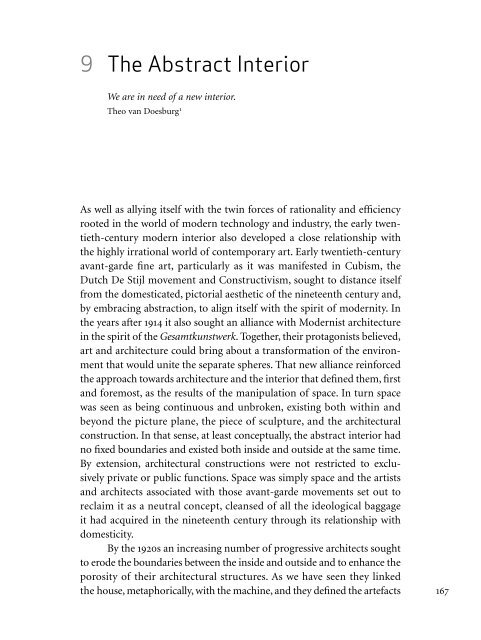You also want an ePaper? Increase the reach of your titles
YUMPU automatically turns print PDFs into web optimized ePapers that Google loves.
9 <strong>The</strong> Abstract <strong>Interior</strong><br />
We are in need of a new interior.<br />
<strong>The</strong>o van Doesburg 1<br />
As well as allying itself with the twin forces of rationality and efficiency<br />
rooted in the world of modern technology and industry, the early twentieth-century<br />
modern interior also developed a close relationship with<br />
the highly irrational world of contemporary art. Early twentieth-century<br />
avant-garde fine art, particularly as it was manifested in Cubism, the<br />
Dutch De Stijl movement and Constructivism, sought to distance itself<br />
from the domesticated, pictorial aesthetic of the nineteenth century and,<br />
by embracing abstraction, to align itself with the spirit of modernity. In<br />
the years after 1914 it also sought an alliance with <strong>Modern</strong>ist architecture<br />
in the spirit of the Gesamtkunstwerk. Together, their protagonists believed,<br />
art and architecture could bring about a transformation of the environment<br />
that would unite the separate spheres. That new alliance reinforced<br />
the approach towards architecture and the interior that defined them, first<br />
and foremost, as the results of the manipulation of space. In turn space<br />
was seen as being continuous and unbroken, existing both within and<br />
beyond the picture plane, the piece of sculpture, and the architectural<br />
construction. In that sense, at least conceptually, the abstract interior had<br />
no fixed boundaries and existed both inside and outside at the same time.<br />
By extension, architectural constructions were not restricted to exclu -<br />
sively private or public functions. Space was simply space and the artists<br />
and architects associated with those avant-garde movements set out to<br />
reclaim it as a neutral concept, cleansed of all the ideological baggage<br />
it had acquired in the nineteenth century through its relationship with<br />
domesticity.<br />
By the 1920s an increasing number of progressive architects sought<br />
to erode the boundaries between the inside and outside and to enhance the<br />
porosity of their architectural structures. As we have seen they linked<br />
the house, metaphorically, with the machine, and they defined the artefacts 167



